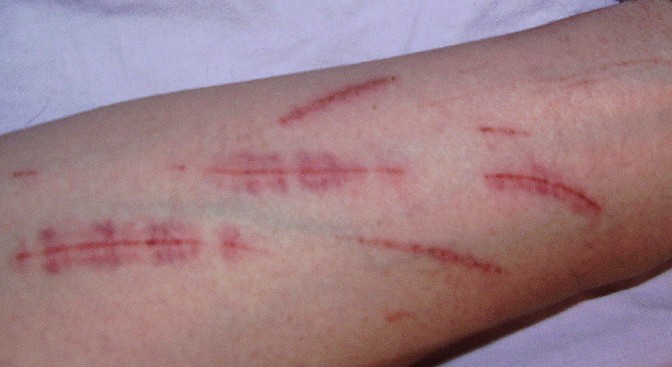One of the categories of content that is blocked by BT and other ISPs relates to self-harm. BT promises that its filters will block ‘sites that promote or encourage self-harm or self-injury’. But as ever, real life is far more nuanced than the headlines. One might be immediately repelled by the idea that THE INTERNET IS MAKING TEENAGERS CUT THEMSELVES (as the Daily Mail might express it), but does this reflect reality? Self-harm is an upsetting idea, but why do people do it, and can it blamed on websites? Alternatively, could sites that provide a forum for openly discussing the subject be therapeutic to those who use them? And are there really sites that exist simply to ‘promote or encourage’ people to self-harm?
One site related to self-harm is Safe Haven, a forum dedicated to discussing related issues, and a quick view of the site seemed to indicate this was an important resource to those who used it. Thread titles such as ‘I Want To Stop Self-Injuring Because…’, ‘To Every Soul That Suffers’, ‘How to deal with relapsing?’ and ‘I don’t know what to do’ indicated that this is a place for troubled people to find company and share their pain. Yet I found the site to be blocked on at least one network (EE).
The very idea that happy, stable people might find such a forum and thus become self-harmers seems (to me as a layperson) to be unlikely. More likely is that this is a classic example of shooting the messenger, which is an impulse that so often underlies censorship: perhaps if we can hide the bad things, they will no longer exist.
But I am no expert, so I approached Dr David Ley, a psychologist based in New Mexico and occasional blogger at this site, and asked him for his views on the site, and the wisdom of blocking it. He responded that, while some people fear that self-harming could escalate to something worse – even to suicide – the evidence appears to contradict this.
‘Although self-harming behavior is quite frightening and concerning, there is actually very little solid evidence that such behavior leads to suicide. In fact, it may be the exact opposite. We often intuitively expect that such behavior is “on the road” to building up to a suicide attempt. But, in fact, there are many reasons why people engage in such behaviors, and many of them are in fact, quite adaptive. For instance, over the years, I’ve had patients describe to me that such behavior can help them “ground themselves in reality,” when they are feeling psychically distant from themselves or the world. Others have told me that the pain can help themselves distance themselves from emotional pain.’
And as to the wisdom of trying to prevent troubled people from accessing such information:
‘It is unfortunate and likely counter-productive, to use filtering to try to prevent people from exploring all sides of this issue. It smacks of the old “Just say no” attempts to prevent drug use in children. Such efforts invariably fail, because children and teens know very well that such issues are not as two-dimensional as they are presented. By restricting access to information on sites such as this, which might glorify or encourage self-harming behaviors, filtering is also preventing access to dialogue and ideas from peers who are also attempting to control these desires. Such dialogue and ideas are much more likely to resonate with individuals who are struggling with self-harming desires themselves. Further, there is a great deal of information presented on the site that might be characterized as “harm reduction,” describing how to prevent infection, increase healing, and prevent serious injury. Again, a black and white presentation of the self-harm issue, as reflected by the filtering, actually may increase the dangers of such consequences in individuals who self-harm, and don’t have access to this information.’
I contacted Safe Haven to let them know that their site was being blocked. The site is based in the United States, and the owner seemed somewhat bemused to learn that her site had been censored in Britain. She pointed out that sites like hers are often the first place that troubled teenagers go to when they decide it is time to talk, and can be instrumental in helping them gain the confidence to speak with parents or health services:
‘Young people usually feel safer first reaching out online and getting support and advice from others in similar situations, or who can at least empathize. I feel some people might think young people should only be confiding in trusted adults like their parents or educators, or those manning helplines, but self-harm and mental health issues are taboo and cause such feelings of shame. Sites like mine allow young people to talk freely without worry that people will look at them askance for mentioning self-harm, or without worry they’ll be bullied for being a self-harmer. I see a lot of the members of the forum telling young people to reach out in real life.’
As in so many cases, the impulse to censor something that appears harmful may itself be harmful. The same applies to another blocked subcategory, ‘sites that encourage suicide’, which is, for some reason, tucked away within BT’s Weapons and Violence category. It seems highly unlikely that a non-suicidal person would find such a site and become suicidal; and it seems likely that a suicidal person may find the ability to share their feelings with others to be beneficial, and even life-saving.
The British are famous for our stiff-upper-lip culture, and yet according to the Mental Health Foundation, we also have among the highest self-harming rates in Europe. Perhaps the idea that difficult things are best not seen, heard or discussed is a dangerous one; but this is the driving force behind the UK’s Internet filters.
